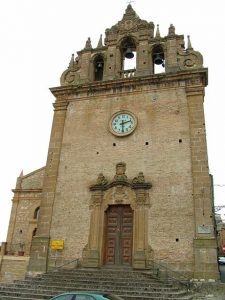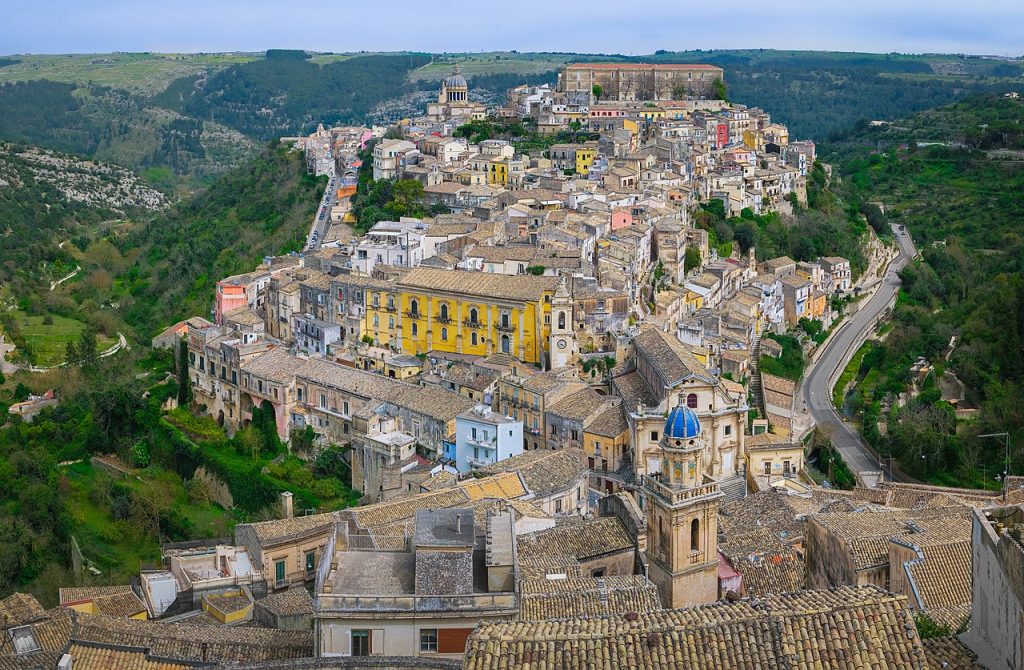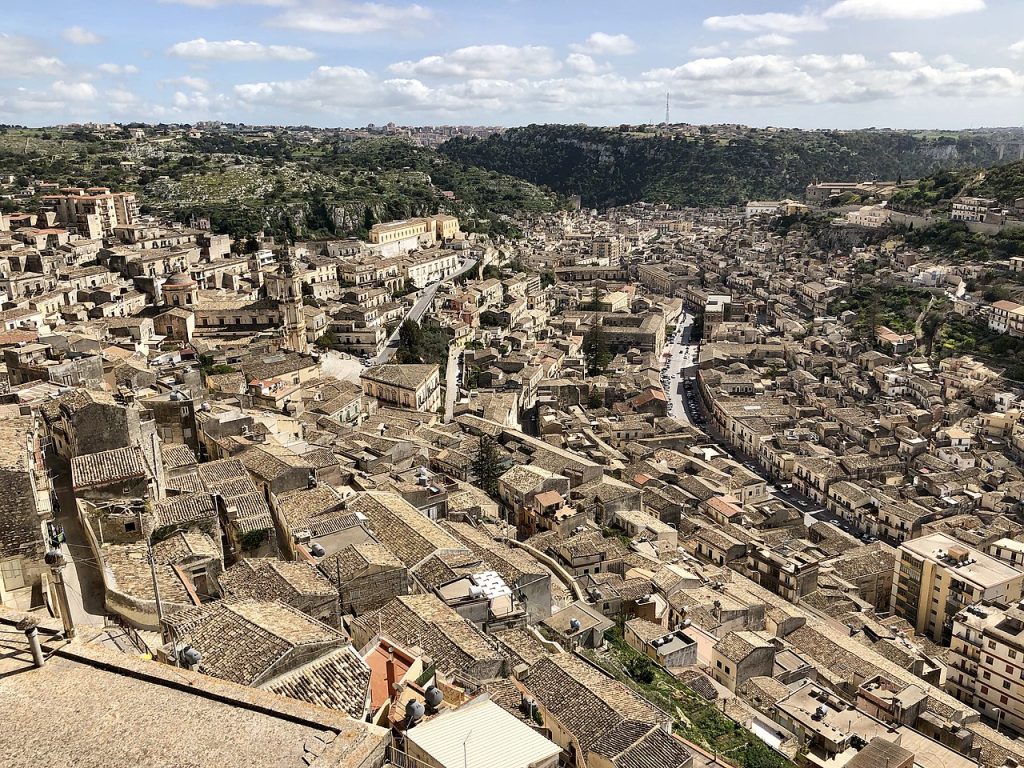Piazza armeria is an Italian city with 21782 citizens, which are included in Enna Consortium and it has the Episcopate seat.
Until 1927 it was the capital of an extended district and seat of sub-prefecture, when the province of Enna, to which it was incorporated, had not yet been established.
It is an ancient medieval town with a fine baroque and Norman historical center. On its territory is the Roman Villa del Casale with its famous mosaics, UNESCO World Heritage Sites since 1997.
City of art, already defined Urbs Opulentissima, with a strong tourist attraction for its important archaeological, historical, artistic and natural heritage, known as the “City of the Mosaics and of the Normans Palio”.
Territory
Piazza Armerina rises up on the top of Erei mountains, in Central and eastern Sicily area, at 697 m in altitude. The city is nestled among sickly and huge woods, full of eucalyptus trees. Its highest pint is at 877 meters above sea level, while the lowest part is at 225 meters; for this reason there is a big altitude profile temperature range between the city centre and the underlying small towns.
Monuments and interesting places
Piazza Armerina is a city of art with a strong tourist attraction for its valuable archaeological, historical, artistic and natural heritage, known as the “City of the Mosaics and the Normans Palio“, is one of 21 candidates for the title of “Capital Italian Culture of 2018 “.
Religious buildings
Piazza Armerina Cathedral, dedicated to Maria Santissima Delle Vittorie, is a large Gothic, Mannerist and Baroque style cult building, with a 40 m high bell tower dating back to the XV century, formerly related to the previous church, where the current cathedral was erected.
San Rocco church (also known as “Fundrò“), dating back to 1613 with a bell gable and rich Baroque portal. The premises of the adjoining Benedictine monastery house the municipal offices.
S. Ignazio church, was the first dedicated to the saints after the beatification. The works for the construction of the factory date back to 1600. The monastery was annexed to the monastery which, under the Jesuits, in 1689, started a university course. Currently the premises of the former monastery partly house a middle school and in part the Municipal Library with the “Exhibition of the ancient book”.
Piazza Armerina is also named “the 100 city churches”:
- Maria SS. delle Grazie Church (1606).
- S. Filippo d’agira Church (1625).
- S. Francesco d’Assisi Church (1742).
- S. Giovanni Evangelista church(1615). Full of frescos about XVIII century Borremans painter.
- S. Giuseppe church.
- Sacro cuore di Gesù church.
- Sant’Antonio da Padova church.
- Madonna dell’Indirizzo church.
- Santa Barbara church.
- San Nicolò church or Madonna della catena.
- Santa Veneranda church.
- Anime Sante del purgatorio church or Madonna della Carità.
- San Vincenzo church.
- S. Lorenzo church (or Teatini church).
- S. Lucia church (XVII century) probably built, on a synagogue place.
- Madonna della Neve church (half XVII century) which has a very simple front but, inside, it has baroque stuccos.
- S. Maria di Gesù church with near aristocrat cemetery.
- S. Martino di Tours church (XII century).
- S. Pietro church (XVII century): for several years it was useful like Pantheon for aristocracy. Next to it, there was a monastery (actually in restoration) and the “Selva”, became then a public garden (usually called “Garibaldi Villa”). The garden has inside different rare species and centuries old plants.
-

See page for author, CC BY-SA 3.0, via Wikimedia Commons S. Stefano church (end XVI century).
- Angeli Custodi church (XVII century).
- Carmine church (XIV century) which has a fine Gothic-Catalan style tower bell.
- Purgatorio church (XVII century).
- SS. Crocifisso collegiate
- Cavalieri di Malta commendation (XII century).
- S. Anna church (XVIII century) with a baroque and concave façade.
- Sant’Andrea Big Priory (1096) which inside has medieval frescos of XII and XV century. It was the Knights of the Holy Sepulcher place, like Sede dei Cavalieri del Santo Sepolcro conte Simone del Vasto donation.
- Fundrò hermitage.
Civil buildings
- Trigona della Floresta Palace, near the Cathedral
- Trigona di S. Elia Palace
- Starrabba Palace
- Trigona di Montagna di Marzo Palace
- Trigona di Dainamare Palace and Canicarao
- Mandrascate Palace
- Trigona di Azzolina e Gallizzi Palace
- Padre Santo tower
- Municipal Palace (ex Senate Palace)
- Garibaldi theatre
- Ancient monumental cemetery and ex Santa Maria del Gesù monastery
Military architecture
- Aragonese Castle
- Capitan Court
Archaeological sites
The Casale Roman Villa
The Casale Roman Villa is a late-ancient residential building, popularly defined as a villa although it does not have the characteristics of the Roman extra urban villa but rather of the noble or imperial urban palace, whose remains are located about four kilometers from the town. Since 1997, with its famous mosaics, it is part of UNESCO World Heritage Sites.
For the realization of the beautiful mosaics of the villa, worked African workers (and perhaps even Roman, as evidenced by some reasons certainly urban derivation) covering an area of about 3500 m².
March Mountain
A few kilometers north-west of Piazza Armerina, is the archaeological area of Montagna di Marzo. Remains of an ancient city lie on about 15 hectares. The settlement, dating back to the Greek-indigenous period (VII century b.C.), had a continuity of life also in the Roman period with frequentations up to the Middle Ages. The urban layout is about Roman origin with the remains of a theater, built after the destruction of the Hellenic town. Furthermore, the Montagna di Marzo area contains a large necropolis.
Sofiana (Philosophiana)
The site, near the river Nociara/Gela, between the municipal territories of Piazza Armerina and Mazzarino, was a statio along the road route that connected Catania to Agrigento and underwent considerable transformations in subsequent eras until it disappeared in the XIII century. The excavations have in fact returned architectures (the domus gentilizia, the thermal structure and, in necropolis, the basilica) and materials that confirm its continued existence from the Archaic period (VI century b.C) up to the Federician one, that is for about two thousand years.
Others
- Ancient book permanent exhibit in Municipal Library “Alceste e Remigio Roccella”
- Municipal gallery
- Diocesan museum
- Permanent Museum of Mining Culture
- Monte Prestami Exhibit Centre
- Garibaldi Theatre
- Villa delle Meraviglie Museum
- House Citizen Museum
- Quattro Canali Fount and medieval laundry
- Calvary, located in front of the sports field, offers a beautiful panorama with an almost total view of the historical center of the city
- Floristella-Grottacalda Mining Park.
Natural Areas
- Ciancio Garden (called also Villetta Roma)
- Garibaldi Garden with San Pietro municipal park
- Bellia municipio wood with trekking and jogging roads
- Ronza Park with equipped
- Natural Reserve Rossomanno Grottascura Bellia
Traditions and Folklore
The most important event is the Normanni Palio, which takes place every year for three days from 12 to 14 August. It is the most important and ancient historical-medieval reconstruction in costume of the South of Italy, with over 600 participants. It is part of the FIGS (Italian Federation of Historical Games) and is registered in the Register of Intangible Heritage (REI) of the Sicilian Region. The event is inspired by the conquest of Sicily by the Normans of Ruggero D’Altavilla who put an end to the Arab domination and created the strong and prosperous Sicily County. The Palio is linked to the tradition of the city of Piazza Armerina and the devotion of the inhabitants to the patron saint of the city and the diocese, Maria SS delle Vittorie, whose ancient painting is kept in the Cathedral and the legend tells that it was donated by the Pope to Ruggero and from these to the city of Platia / Plutia (ancient Piazza Armerina). It is the re-enactment of an episode held in Piazza Armerina in the twelfth century in a charming atmosphere of medieval costumes and sounds, combined with a chivalrous carousel on the quintana style in which the four historic districts of the city compete: Monte, Castellina, Canali, Casalotto. An engaging event, very felt by the piazzesi, which excites all the spectators.
In Piazza Armerina, besides the Normans Palio, other religious parties take place within the community.
- Piazzale Carnival
- On March 18th and 19th you can visit the tables in honor of Saint Joseph at city committees, parish oratories and private homes.
- The Holy Week in Piazza comes to life on Holy Thursday where you can visit the altars of the reposition in all the churches in the square and listen to the complaints during the night that are performed on the main streets of the city. On Good Friday, in the late afternoon, the evocative procession of the Crucified Christ takes place, followed by the mother dressed in a black cloak carried in procession by the women in a simple black dress and finally there is another statue depicting the Christ of the urn.
- The last Sunday in April, in the morning, takes place the procession of the Holy Mary of Piazza Vecchia carried on the shoulders by the youth of the Marian association, the procession starts from the hermitage up to the church of the Guardian Angels located in the Monte district, the Madonna entered the district with the festive firing of the fireworks along the procession there are many faithful who give flowers to him. The Holy Mary stays in town until the 3rd May.
- On afternoon 1st May, the procession of Saint Joseph the worker takes place, the Saint, on the occasion of the Madonna in the city, enters the church of the Angels to make sure that Saint Joseph greets the Madonna.
- On 2nd May, the procession of the Madonna di Piazza Vecchia takes place. At a certain point, the consecration to the city takes place in the Cathedral.
- On 3rd May, local feast in honor of the discovery of the sacred image of Maria Santissima delle Vittorie, the Mass is celebrated in Cathedral and then the procession takes place to bring the Madonna back to the hermitage of Piazza Vecchia.
In the afternoon in Contrada Indirizzo are organized country games for children such as tug of war, breaking pots, running with bags, there are singers, but above all there is the tree of the dog formed by a tall tree where in top there are many prizes, the piazzesi call it “a gioia” and to finish the evening of the wonderful fireworks. - On Sunday after 12th May, San Filippo D’Agira is celebrated in the neighborhood with a procession that starts at 10:00 am from its homonymous church to wind its way in procession up to the mountain district where at 12:00 am it stops at the church of the crucifix immediately after the stop returns to the church of Santo Stefano until the evening. In the evening around 19:00 pm the evening procession begins, the most important part of the party and the procession along the streets, stairways and alleys of the neighborhood home in which streets balconies are festively decorated by flags and lights and the passage of the holy rose petals finally, the pyrotechnic specter can not be omitted.
Characteristic of the party are the harnessed horses and the children dressed as peasants and little angels. - The following Sunday, 24th May is the procession to Maria Ausiliatrice.
- Procession of the Corpus Domini from the Cathedral to the church of Sant’Antonio.
- In July or August there is the “relive the history” procession in which the most beautiful parades of Sicily take part.
- On 15th August procession of Maria SS delle Vittorie, Protector of piazzesi people and of the diocese.
- The Sunday after 13th October there is the procession of Madonna di Fatima.
- Second Sunday of November there is the procession of Santa Veneranda patron of the castellina neighborhood.
- 4th December procession of Santa Barbara
- 8th December, the Immaculate Conception procession.
- 13th December, the internal feast of Saint Lucia, patron of the Canali district, after the religious services in the evening in the square in front of the cuccìa festival. The Saturday following the procession with the simulacrum of Santa Lucia through the streets of the city on the return of fireworks from the Piano Canali.
- From 16th till 24th December there are Christmas novels along the streets, alleys, courtyards and squares with Christmas carols played by the band.
- 26th December procession of Saint Stephen.

